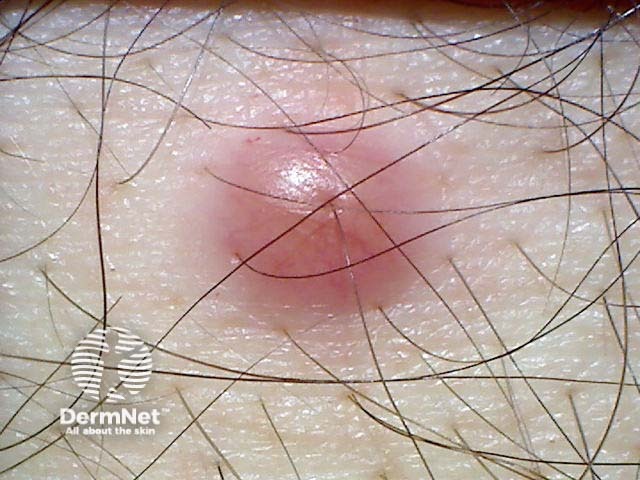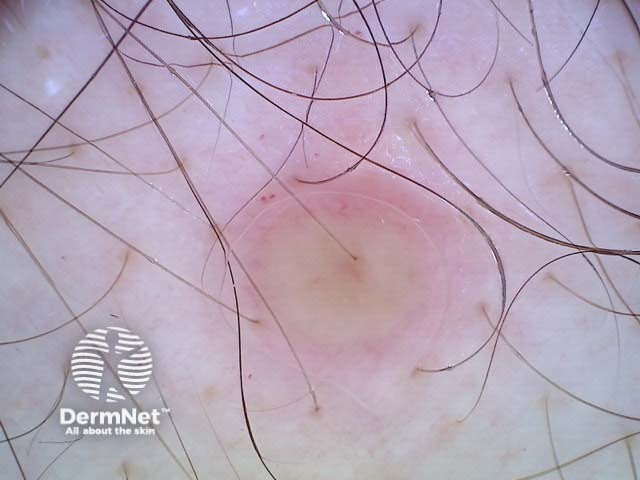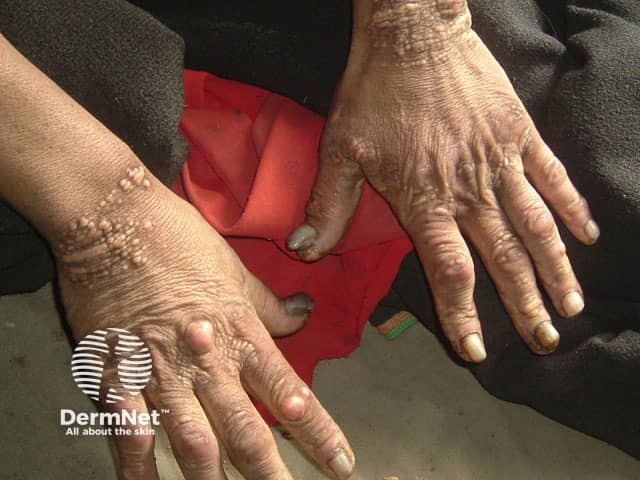Main menu
Common skin conditions

NEWS
Join DermNet PRO
Read more
Quick links
Authors: Vanessa Ngan, Staff Writer; and Dr Amy Stanway, Dermatology Registrar, Nottingham, United Kingdom, 2004.
Introduction Introduction - solitary reticulohistiocytoma Multiple skin lesions Introduction - multicentric reticulohistiocytosis Causes Treatment
Reticulohistiocytosis is a rare form of histiocytosis that can affect the skin and other organs.
Reticulohistiocytosis has a wide range of severity. It can be a limited disease with a single yellowish-red skin lump through to multiple skin lesions with internal organ involvement. It usually occurs in adults.
Solitary reticulohistiocytoma refers to a single skin lesion (also known as ‘solitary reticulohistiocytosis’ or ‘solitary histiocytoma’). It tends to spontaneously resolve over a period of months to years and affected individuals remain healthy.
Surgical removal of solitary skin lesions usually results in a cure.


Dermoscopy view
Reticulocytosis may present with multiple skin lesions, in which case there is a high chance of other organs being involved. These may include:
Symptoms may include weight loss and fever. Blood tests may reveal anaemia, and increased cholesterol is present in one third of patients. Heart involvement may be fatal.
Multicentric reticulohistiocytosis is sometimes also referred to as ‘lipoid dermatoarthritis’, ‘lipoid rheumatism’, and ‘giant cell reticulohistiocytosis’.
Multicentric reticulohistiocytosis is a very rare and more aggressive condition characterised by skin lesions, mucosal lesions and arthritis. It usually arises in middle-aged women. In one-half of patients, the first sign of the disease is arthritis, whilst one quarter first develop skin papules (small bumps) and nodules (larger lumps), and the remainder develop skin and joint manifestations at the same time. It is classified with other proliferative disorders of histiocytes (a type of immune cell).
Feature of skin lesions include:
Arthritis most commonly involves the fingers, hands, knees and shoulders but any joint can be affected. The symptoms of arthritis may wax and wane, but can rapidly become severe and lead to joint destruction and deformity. About 45% of patients suffer severe arthritis.

Multicentric reticulohistiocytosis: Swinfen Charitable Trust

Multicentric reticulohistiocytosis: Swinfen Charitable Trust

Multicentric reticulohistiocytosis: Swinfen Charitable Trust
The cause of multicentric reticulohistiocytosis is unknown but in about 20-30% of cases, the disease is associated with an underlying malignancy. If there are multiple skin lesions but no arthritis then there is no association with cancer. Controversy exists about whether multicentric reticulohistiocytosis is a true paraneoplastic disorder (a paraneoplastic disorder is one that occurs as a result of circulating factor(s) produced by underlying cancer). Reasons for this include:
Multicentric Reticulohistiocytosis is also associated with:
There is no specific treatment for multicentric reticulohistiocytosis. In many patients, after an average course of 8 years, the disease can go into remission, however, by this time considerable joint destruction may have occurred. Patients are left with crippling, deformed joints and disfigured facial appearance.
Because approximately 30% of cases may stem from underlying malignancy, evaluation for a possible malignancy is essential. Thorough history taking and physical examination with age-appropriate cancer screening are recommended if symptoms of multicentric reticulohistiocytosis are present.
The following treatments may be used: